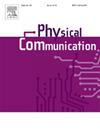Generative AI-driven reinforcement learning for beamforming and scheduling in multi-cell MIMO-NOMA systems
IF 2.2
4区 计算机科学
Q3 ENGINEERING, ELECTRICAL & ELECTRONIC
引用次数: 0
Abstract
This article introduces a novel generative artificial intelligence-enhanced primal–dual proximal policy optimization (GAI-PDPPO) framework for joint user scheduling and beamforming in downlink multi-cell multiple-input and multiple-output non-orthogonal multiple access (MC-MIMO-NOMA) networks. Designed to address the challenges of interference-laden environments typical in beyond the fifth generation (B5G)/sixth generation (6G) systems, the proposed method formulates a complex mixed-integer nonlinear programming problem to minimize transmit power under stringent Quality-of-Service (QoS) constraints. Unlike conventional approaches, GAI-PDPPO incorporates an invertible transformer-based actor-critic architecture capable of modeling high-dimensional channel state information and unknown-source interference. Through the integration of generative pretraining and prioritized experience replay, the framework accelerates convergence and enhances policy generalization. Extensive simulations demonstrate that GAI-PDPPO consistently outperforms standard primal–dual PPO and benchmark solutions, achieving lower power consumption and higher spectral efficiency under varying signal-to-interference-plus-noise ratio (SINR) thresholds and interference conditions.
多单元MIMO-NOMA系统波束形成与调度的生成式ai驱动强化学习
针对下行链路多小区多输入多输出非正交多址(MC-MIMO-NOMA)网络中的联合用户调度和波束形成问题,提出了一种新的生成式人工智能增强的原始-对偶近端策略优化(GAI-PDPPO)框架。为了解决第五代(B5G)/第六代(6G)系统中典型的干扰环境的挑战,该方法制定了一个复杂的混合整数非线性规划问题,以在严格的服务质量(QoS)约束下最小化发射功率。与传统方法不同,GAI-PDPPO采用了一种基于可逆变压器的actor-critic架构,能够对高维通道状态信息和未知源干扰进行建模。该框架通过生成式预训练和优先经验重播的融合,加快了收敛速度,增强了策略泛化能力。大量的仿真表明,在不同的信噪比(SINR)阈值和干扰条件下,GAI-PDPPO始终优于标准的原对偶PPO和基准解决方案,实现了更低的功耗和更高的频谱效率。
本文章由计算机程序翻译,如有差异,请以英文原文为准。
求助全文
约1分钟内获得全文
求助全文
来源期刊

Physical Communication
ENGINEERING, ELECTRICAL & ELECTRONICTELECO-TELECOMMUNICATIONS
CiteScore
5.00
自引率
9.10%
发文量
212
审稿时长
55 days
期刊介绍:
PHYCOM: Physical Communication is an international and archival journal providing complete coverage of all topics of interest to those involved in all aspects of physical layer communications. Theoretical research contributions presenting new techniques, concepts or analyses, applied contributions reporting on experiences and experiments, and tutorials are published.
Topics of interest include but are not limited to:
Physical layer issues of Wireless Local Area Networks, WiMAX, Wireless Mesh Networks, Sensor and Ad Hoc Networks, PCS Systems; Radio access protocols and algorithms for the physical layer; Spread Spectrum Communications; Channel Modeling; Detection and Estimation; Modulation and Coding; Multiplexing and Carrier Techniques; Broadband Wireless Communications; Wireless Personal Communications; Multi-user Detection; Signal Separation and Interference rejection: Multimedia Communications over Wireless; DSP Applications to Wireless Systems; Experimental and Prototype Results; Multiple Access Techniques; Space-time Processing; Synchronization Techniques; Error Control Techniques; Cryptography; Software Radios; Tracking; Resource Allocation and Inference Management; Multi-rate and Multi-carrier Communications; Cross layer Design and Optimization; Propagation and Channel Characterization; OFDM Systems; MIMO Systems; Ultra-Wideband Communications; Cognitive Radio System Architectures; Platforms and Hardware Implementations for the Support of Cognitive, Radio Systems; Cognitive Radio Resource Management and Dynamic Spectrum Sharing.
 求助内容:
求助内容: 应助结果提醒方式:
应助结果提醒方式:


